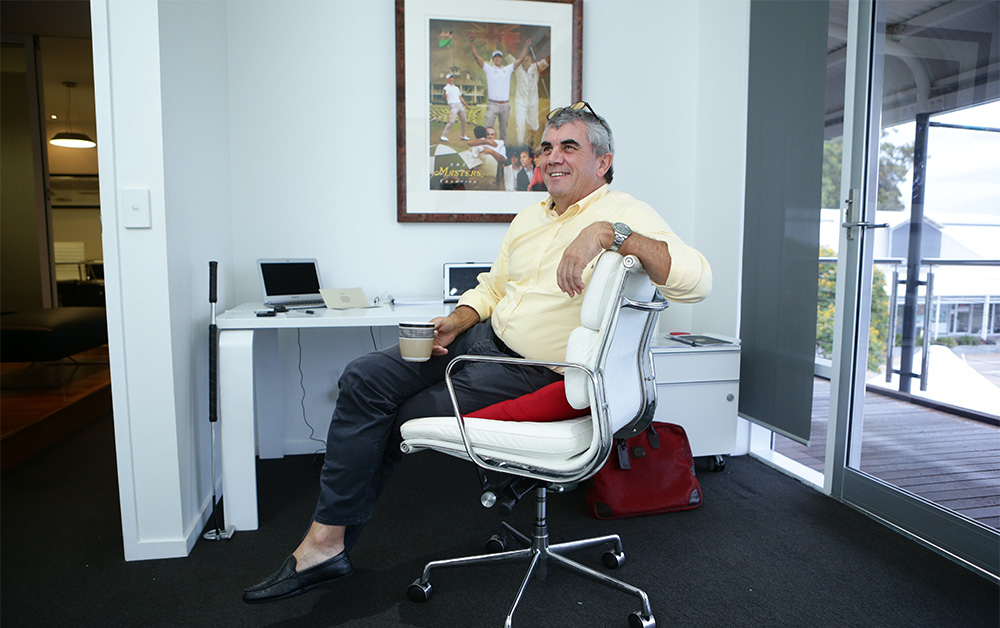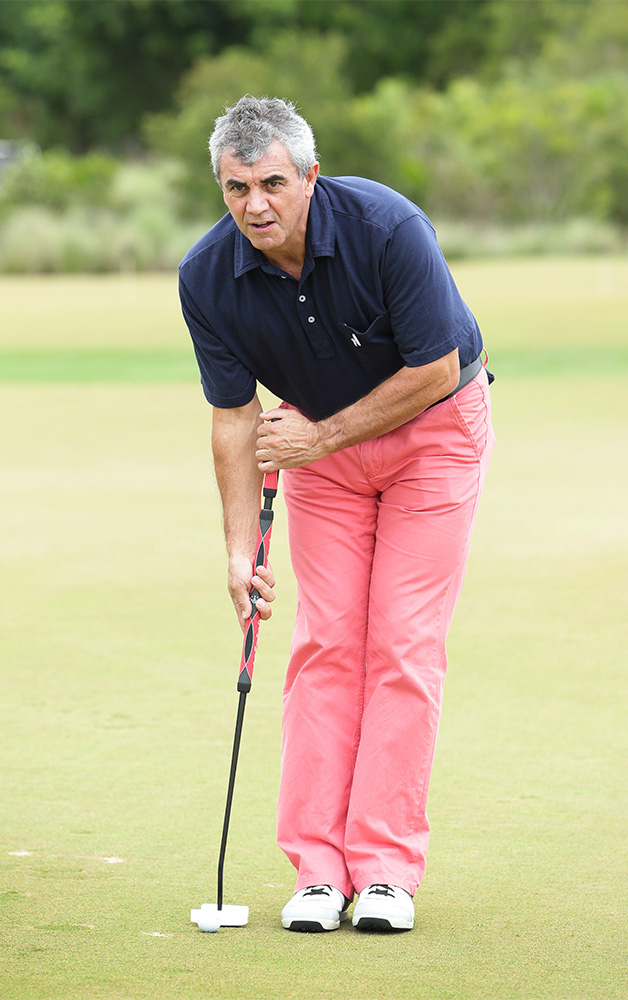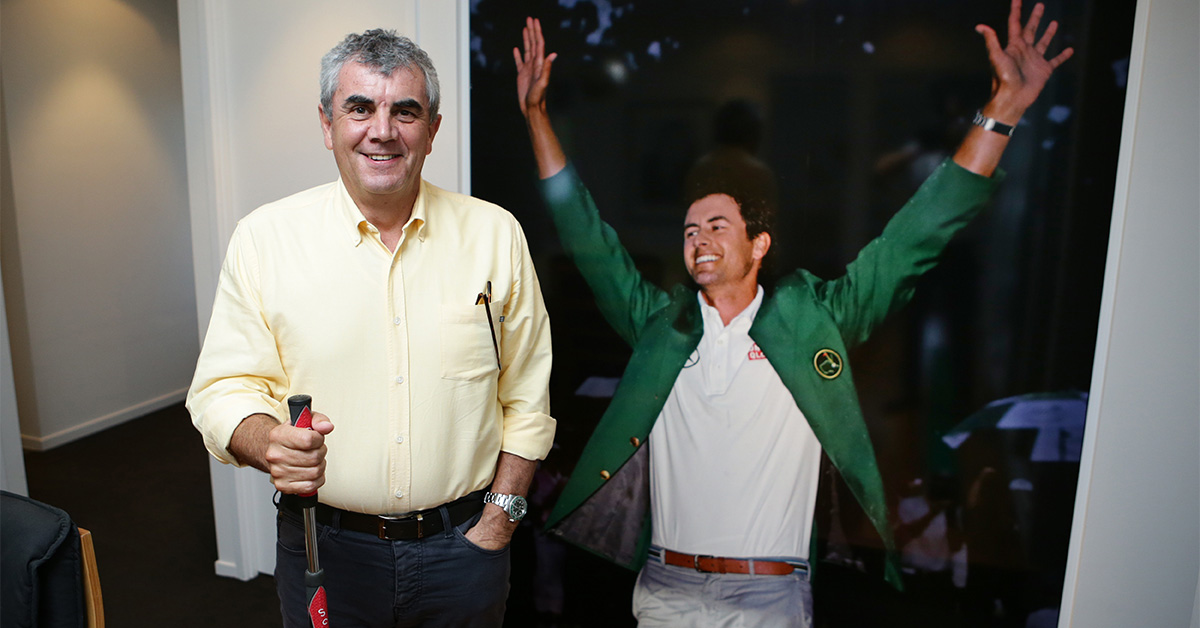Phil Scott on mastering fatherhood, switching to side-saddle and silencing his son’s critics.
Phil Scott is a hard man to track down.
The globetrotting “old pro” and father of 2013 Masters champion Adam Scott spends most of his days managing his son’s business affairs. In fact, he was bouncing between Australia, the United States and Switzerland before we nailed him down for a heart-to-heart on what it’s really like to raise one of Australia’s most marketable athletes. We also asked him about one of his favourite subjects – putting. And while it hasn’t always been plain sailing in the Bahamas sunshine or donning green jackets for this dynamic father-son duo, as the 61-year-old so wisely puts it: “In golf, sometimes you have to lose a few battles to win the war.”
 Well, another year, another Father’s Day in the Scott household. Any memorable gifts from Adam over the years?
Well, another year, another Father’s Day in the Scott household. Any memorable gifts from Adam over the years?
I can’t remember one! These days we are never together on Father’s Day, and of course they are on different days in Australia and the USA. But, to his credit, he always sends me a message or calls me, so that’s good enough.
How would you describe yourself as a father?
Maybe my kids would be better to judge me as a father. I think my best trait has been a provider of opportunity and a supporter to my kids. That’s the best gift I could give them.
How has fatherhood changed Adam, both as a person and golfer?
He’s very patient – a good trait as a parent, I think. He’s also busier now as a dad, like all parents with young kids. So finding time for everything is harder and completely switching off is a rarity.
Adam always comes across as a model human being, with seemingly no bad traits or flaws. Did he ever test your parenting skills growing up?
I’m sure he did. He had his moments, but age may be clouding my memory somewhat. Even as a kid he was quite calm and peaceful, traits inherited from his mother, for sure. He tested my patience when he started beating me easily on the golf course! His mother, another model human, thought it was great.
With Adam Scott now a global brand, how have you juggled your roles as Phil Scott the manager and Phil Scott the father?
We’ve been aware of the difficulties from the outset and certainly in the early days we were very conscious of switching hats, as it were. Less so now – Adam is a mature and worldly man, and we are both experienced at what it takes to keep in harmony. We don’t always agree but we acknowledge each other’s strengths and weaknesses and go from there. Sometimes I think it’s harder for other people to separate the two roles than it is for me.

Any advice for other fathers out there who may be raising an elite athlete?
The sport is the driver, the business is the passenger.
What’s the most important piece of advice you’ve given Adam?
Listen to your mother!
Like it is with Adam, we understand putting and Phil Scott has been a love/hate relationship over the journey. What’s the story?
I think putting is a love/hate relationship for all golfers. It is the ultimate measure of our score, and so effects us instantly… whether the putt is made or missed. For me, I have always enjoyed experimenting with putting and putters and exploring the concepts involved. Sometimes that experimenting is successful, sometimes it’s not.
As a long-time PGA pro and father of Australia’s only Masters champion, where do people really get it wrong on the greens, from your experience?
Out of the three main variables – pace, line and technique – I think most golfers spend too much time on the line and not enough on the correct pace. Hence, medium-to-long putts finish too far from the hole and, consequently, the next putt is often missed. Longer putts are all about pace – it’s not that hard to see a basic line but pace is paramount. Short putts are more about line and precision. So the closer the long putt can finish the easier the short one. Spending more time practising putting, particularly long putts, will make a huge difference… and it’s not a stressful practice.
You’ve told us previously that when people can disengage the brain, putting is easy. What’s the secret to achieving this?
I’m sure different people have different methods of “switching off”. Putting the brain in neutral allows natural instinct to take over, which will provide the best results. Because putting immediately reflects the result for that hole, there is a great fear of consequence and that gets the brain active, sending all sorts of destructive and confusing messages: “don’t hit it too hard”, “keep the stroke smooth”, “stay still”, etc. There has been proven success with proper breathing techniques as a means of quietening the mind in many sports disciplines – that could be a topic on its own! For now, as an example of an ideal mindset, think of scrunching up a piece of paper and throwing it in the bin – we look quickly at where we want the paper to go and then just go ahead and throw it.
 With so much new product available, amateurs can have a tendency to chop and change their putters far too frequently. Are you guilty of this? If so, what have you learnt?
With so much new product available, amateurs can have a tendency to chop and change their putters far too frequently. Are you guilty of this? If so, what have you learnt?
It’s interesting you think that’s a problem? Trialling new products can be fun. You soon find out whether you like the new putter or not. Not an issue in my mind, so I certainly feel no guilt. It’s just a subjective debate. Try the new products or stick with what you know and like? I say, whatever you like! It is certain that the new putters are more forgiving and stable and that should make it easier to putt well but technology does not account for all the human factors.
At a guess, how many different putters have gone into your bag over the years?
Hmmm … 50? No, much more than that… 100? Yes, maybe a few more than that…
Any favourites?
An old-fashioned blade putter still looks beautiful set behind the ball to me – hard to putt with, though. I like the Scotty Cameron Futura X because it reminds me of Adam’s Masters win. But the Lateral Line L2 might be the easiest putter to putt with… ever.
You’re a big believer in side-saddle putting made famous by Sam Snead. Why?
Being face-on makes sense to me. We do basically everything using binocular vision and so facing the target makes it easy and natural to see the lines. The technique of the stroke is really easy too – it’s as simple as letting your arm swing as it does when you walk, or rolling a ball along the ground. However, it is somewhere between difficult and impossible to get a really good side-saddle putter to use.
“Being face-on makes sense to me. We do basically everything using binocular vision and so facing the target makes it easy and natural to see the lines.” – Phil Scott
You must get weird looks and questions from your playing partners?
That happens. But I don’t always putt side-saddle. The point you make, though – the look – is a big reason why we don’t see more of it and why pros won’t do it. It seems, too, that the authorities don’t like it. Bryson DeChambeau came out on tour using that method and the USGA kept finding an issue with his putter. Hmmm?
Have you ever convinced Adam to give side-saddle a try? How did it go?
Not in any serious way, no. He has hit putts side-saddle and can certainly understand the merits and the science behind it.
Do you feel partly to blame for Adam’s penchant for switching between long and conventional length putters? Sons do tend to turn to their fathers for inspiration, after all.
Definitely 100 percent not! I’m sure I am not the golfing inspiration for Adam. Maybe more the reverse…
What have been your key messages for Adam in relation to his putting woes? Was there a pivotal father-son conversation that stands out?
Well, I’m not Adam’s coach so my messages are more conversational than instructional. My belief, for sure, is he should stick with what he does best. He plays for a living so he doesn’t need to risk poor performance by unnecessary experimentation.
Adam has been heavily maligned for his putting for much of his career. Justified or unfair? Sometimes both. It is what it is. He’s won roughly 30 events, been No.1 in the world, won the Masters… It can’t be too bad. He’s always been a streaky putter, even as a junior golfer, and can miss the unexpected short one more than others, so I think it often looks worse than it is. Media love the negative story, and the public follow the media, and so next thing every club golfer says Adam is a bad putter. Trust me, if you are a bad putter you aren’t on tour.
“Media love the negative story, and the public follow the media, and so next thing every club golfer says Adam is a bad putter. Trust me, if you are a bad putter you aren’t on tour.” – Phil Scott
What’s the most ridiculous thing you’ve seen, read or heard in relation to Adam’s putting? American crowds yelling “cheat” when he uses a (non-anchored) long putter – pretty silly, hurtful and ignorant. Hopefully just Budweiser-induced. There was a failed European pro blogging that Adam was anchoring during The Open at Carnoustie last year… no beer involved, just ignorant.
Has the criticism finally got to Adam and exacerbated the problem, taking it from a technical issue to a mental one?
I believe it’s not the criticism so much as constant focus. At times I’m sure it annoys him and logically constant focus keeps things front of mind.
“There was a failed European pro blogging that Adam was anchoring during The Open at Carnoustie last year… no beer involved, just ignorant.” – Phil Scott
What percentage of practice time does Adam devote to putting – and how much time should amateurs dedicate to the craft?
Adam’s time spent varies so let’s deal with the amateur golfer on this. Best to think of it as a percentage – 50 percent of all practice time would be good. Just as importantly is frequency. Some putting every day is hugely beneficial.
Adam is a high-profile student of the AimPoint method of putting. Myth or magic?
AimPoint is an interesting process. Golfers have used their feet for years to “feel” the break. AimPoint is really an extension of that feel, making an assessment of the variable or percentage of break and then being able to establish an “aiming point” from that. That’s a very simple overview of a method with some solid scientific principles, so it’s neither myth nor magic. One thing I really like is it provides a definite committed line, which is a huge plus.
Adam seems to be such a great putter from long range but, at times, almost unwatchable from inside five feet. What do you put this down to?
Like all golfers there is a much greater freedom of mind on longer putts, holing the putt is a “bonus” and there is no fear of missing. Short putts have the unchangeable consequence – in or miss. When he is on a negative putting streak his weak point is the short putt.

If Adam could have one player’s putting game, who would you like it to be – and how many wins could he realistically have today?
Whether he would have more or less wins is supposition, isn’t it? Would he have struck the ball as well? Let’s not guess at that and think about lovely putting strokes of the modern time. Rickie Fowler: very natural. Brooks Koepka: it works. Jason Day: consistently good. One of them, I think.
Is there one lesson we can all learn from Adam’s battle on the greens, good or bad?
Adam’s been around a while, hasn’t he? And it’s only one lesson? So let’s go with: “You have to lose a few battles to win the war.”
Flagstick in, like Adam, or out? Why?
For club golfers on long putts – in. There are no negatives and it should make the round go a little quicker. On short putts it’s personal preference. I like it out, particularly if the putt has a lot of break. Moving forward it will be interesting to see if any of the organisations change the pin material or thickness.
OK, last one: You and Adam have 50 putts each, from all distances, speeds and breaks. Who wins?
That’s good! I’d actually like to do this comp one day. Slow greens, I might win (he’s not used to them). Fast greens, he wins (I’m not used to them). Breaking greens, relates to pace so as above. A little practice on both types of greens and he wins. Who am I kidding? As I answer this he’s ranked 48th in Strokes Gained-Putting on the PGA Tour in 2019. He wins!
Phil Scott spoke with Brad Clifton




